|
|
||
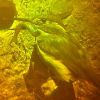
|
I like simple representation of wild animals on holograms. You could find quite a few birds on photopolymer (see my french collection below), but I don't know if it was a genuine serie or not. Anyway, here is a nice and small kingfisher. On film. [8x10 inches / 20x25 cm] | |

|
Another piece of History from a museum. It's a small head from an egyptian statue. On film. [4x5 inches / 10x12.5 cm] | |

|
Just some bicycle spokes. Nothing really exciting, but it's kind of original. On film. [8x10 inches / 20x25 cm] | |

|
A strange portrait of a robotic girl. It's done with a technique combining two different holograms into one, and using a sort of mask so both holograms will appear at the right place. Here the sunglasses and the mouth of the girl are actually holes, and through them you can see another hologram that shows gears, electric or electronic mechanisms inside. On film. [8x10 inches / 20x25 cm] | |
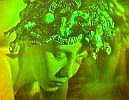
|
It's beautiful. I know I write that word a lot, What else can I say? I buy holograms I love. This one is a very nice portrait / sculpture of a young woman with eyes closed, her hair being a bunch of tubes looking like snakes. On film. [8x10 inches / 20x25 cm] | |

|
A pretty unique piece that mixes two of my passions: holography and calligraphy. It's an historical Koran, very old, probably from the British Museum, that was shot in the early eighties by the famous Richmond Holographic Studios, with a pulsed laser. I think more and more that holography can be an excellent medium for displaying significant historical pieces of art. This is a reflection copy on glass. [12x16 inches / 30x40 cm] | |
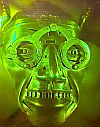
|
Some of the most beautiful mass-produced holograms, because they show incredible historical artifacts, and they are very bright, even if they are on film. I was after them since maybe ten years, and finally found them on eBay. It's a serie of three helmets from royal armours of British Kings. Unlike many holograms, they were sold with a small 2-pages booklet that explained the historical background of the helmets, which I think was a great idea. They were shot by Rob Munday, an english holographer, in 1989. Jonathan Ross has the original versions on glass plates, which show much more. [all 8x10 inches / 20x25 cm] | |

|
It looks like companies commercially producing holograms liked to do series of images with similar subjects. For example, there was this beautiful serie of historical helmets above. Or the dichromate gun serie below. Here is another one, apparently distributed (or made?) by a now defunct american company called Lazer Wizardry. They are small dichromate holograms on glass of various fossils. Of course I have always enjoyed fossils, so I bought all of them at once from an eBay reseller. [all 4x5 inches / 10x12 cm] | |

|
I saw this hologram for the first time more than ten years ago. At this time, it was way too expensive for me, even if it's one of those mass-produced photopolymers that are (relatively) common. I finally bought it on eBay a few monthes ago for a very low price. The tiger nose appears to pop out like 20 cm in front of the frame. But curiously, I would say it's too much, and there are some pretty visible deformation. The parallax is very limited too. If you move a little bit from the middle axis of the film, the image disappears quickly. But the jaw and the size are impressive. [12x16 inches / 30x40 cm] | |

|
A very nice example of modern DCG (dichromated gelatin) hologram: "shamefully bright" as someone said, and crisp. Dinesh and Joy Padiyar at Triple Take Holographics hand-make beautiful small (and cheap) holograms to enhance everyday objects, like coasters, clocks, or photo frames. They are frequent contributors to the holography forum too. I like reptiles, so I had to buy some of their geckos. Lovely holograms on glass. [3.5x3.5 inches / 9x9 cm and 4x5 inches / 10x12 cm] | |

|
The only example I have of a multiplex stereographic hologram. It's from unknown origin (I bought it on eBay), but I suspect it was made by Lloyd Cross and associates, in San Francisco, in the seventies. Not a lot of people produced commercially this very special kind of hologram. I just know about Lloyd Cross and Jason Sapan, actually. The most famous one is "The Kiss". It's actually a multitude of parallel small hologram strips one after the other on a long piece of film, which is then rolled as a cylinder. Add a light above, and the object magicaly appears in the middle of the cylinder. They are usually done from successive 2D photographies, or frames from a movie (which is the same), so they can contain movement. To be frank, the quality of this one is very poor. It's very small and there is no details at all. But I like it anyway, let's say for the historical value. [I will check later, but from memory I would say 2x20 inches / 5x50 cm] | |
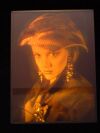
|
Finally I got it. One of the holograms that almost started it all. I saw this hologram around 1992 or 1993 in an expo in Madrid, and never forgot about it. An excellent portrait of a girl with a weird hat that can hide her eyes depending on the angle you're looking at her. I even remembered the name of the artist who created it, an english holographer called Patrick Boyd. Even if it was just a flat photography it would be a nice portrait, but the depth, and the manner Boyd played with it, really makes this image unique. It's just exactly the type of hologram I love: technically simple (a portrait, just one image, no tricks) but beautifully composed with a photographer's mind. Ten years later, I finally could buy a copy of Lucy, directly from the artist. My copy unfortunately has a broken corner, but it's not really a problem (and it came much cheaper). [12x16 inches / 30x40 cm] | |
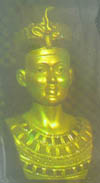
|
Kris Meerlo is fairly known as one of the best hobbyist holographers in the world, and one of the most helpful experimenters too, always ready to give you a hand or share some new tricks he learnt through his experience first with HeNe lasers, and now with powerful red laser diodes. It's evident when you see his impressive website. But now i'm absolutely sure, because I have right here one of his beautiful holograms he just sent to me. Click on the small image on the left to know what I mean. This gorgeous Egyptian Queen is the result of Kris experiments with his HB 50 mW / 650 nm laser diode from HB-Lasers at around $200. The hologram is pretty bright, and has a nice green-yellow color, probably not easy to obtain through TEA with these far red diodes. One of the good ideas he had was to put an easy-to-follow checkered background, so you can have an idea about the depth of the hologram, which I would say is around 20-25 centimeters (10 inches). My photos are fuzzy as usual, but I think you can have a good idea. Technical comments: Chemistry: Pyrogallol developer and dichromate reversal bleach. Film: Redstar. Laser: LDM650/50 laserdiode module powered with batteries (NiMh pack 7.2 volt). Output power: About 50 mWatt, no warm-up time. Used optics: Parabolic mirror, 1/2 wave plate, spatial filter. Exposure time: About 2 seconds, using a cardboard as shutter. Colour of the statue: Gold. Index Matching and TEA: Yes for both. [5x7.5 inches / 13x20 cm] | |

|
First of a serie of 3 dichromate holograms on glass from apparently the same "old guns" serie. This one is a Colt .352 magnum revolver. As all dichromated gelatine holograms, they are very bright, and don't even need a dedicated lamp to appear perfectly. They have a wide parallax too. I bet they were done by single-beam Denisyuk technique. The company producing them doesn't exist anymore since years. Bought from Olav Skipnes, Norway, a very nice guy who once had a holography museum and laboratory in his city of Hamar. [8x10 inches / 20x25 cm]
SOLD 2011 |
|

|
Second one of the serie, still beautiful, a famous Derringer, used by poker professional players and women because of their small size. It's a bit smaller, I need to check the exact size. I bought this one from Derek Galon, Canada, a very sympathic hologram collector and reseller, who really loves his job. He has a shop near Vancouver, the Royal Holographic Art Gallery. Check his on-line store, because he has very rare limited holographic art and masterpieces you cannot find elsewhere. [8x10 inches / 20x25 cm]
SOLD 2011 |
|

|
Third one of the serie, and if i'm not wrong it's a german luger from world war II. Bought from Derek Galon again. [8x10 inches / 20x25 cm]
SOLD 2011 |
|

|
Let's continue with two other dichromated nice holograms on glass I bought on eBay from MWK industries, resellers of laser stuff. A nice deal I think, because dichromated holograms of this size are hard to find. This face is extremely bright, I love it. I have no idea who made them. [8x10 inches / 20x25 cm] | |

|
Bought with the face above, a funny skull with glasses. A bit less beautiful than the face, but the funny part is - I think - the glasses are themselves holograms. Hologram of an hologram. [8x10 inches / 20x25 cm] | |

|
Another dichromated gelatine hologram, on glass, of course. I love it for several reasons. First, of course, it's very bright and sharp. Second, the Nautilus shell is naturally a beautiful shape, almost a perfect logarithmic spiral. Third, it's transparent. Generally, to enhance the contrast of holograms, people put a black layer on the background. Here, as it is very bright, it does not even need it. And you have this nice impression that the shell is floating in the middle of nowhere. The fourth reason is that it's almost an "historical" hologram. If i'm not wrong, it was made in 1979 by Fred Unterseher, a pioneer in holography and certainly one of the guys who did a lot to bring holography to the masses, for example by cowriting the famous "Holography Handbook" that every hobbyist holographer uses (me included). Jonathan Ross has the same hologram in his impressive collection. I bought this one from Olav Skipnes in Norway. [4x5 inches / 10x12.5 cm] | |

|
A more classic one. Classic in the sense that it's easy to find, and of course not very expensive. But I still love it. I actually saw it years ago and fell in love with this pulsed portrait of cute lion cubs. I finally bought it when I came in the US. Olav Skipnes has a glass copy for sale, which are generally much brighter and nice (although more fragile too) but I bought a film copy from Derek Galon before. [12x16 inches / 30x40 cm] | |

|
Narcissism at its best. My dream since 15 years, and my largest hologram so far. It's my own portrait! It was made by Rob and Sharonda Taylor from 4th Dimension Holographics in the US, using a GP2J laser system from Geola. Rob allowed me to follow all the procedure, from the transmission master shooting (yes, I took a 2 Joules flash of green light in my face, which lasted around 30 nanoseconds) and development, to the final reflection copies on glass (i have 2) visible in white light. Rob and Sharonda also have a very nice museum close to their studio, with an impressive collection, including half a dozen of color holograms by Hans Bjelkhagen. As a whole, I spent a very nice day with them. Great people doing a great job. If I remember well, I was their client no 24 for a portrait :) A hint if you wanna pay them a visit: don't try to go there without a car! It's a charming town, but a little bit in the middle of nowhere, one hour drive from Indianapolis. Last thing to mention, this studio is probably the cheapest in the US, and maybe in the world - and believe me, I've checked every possibility. Rob and Sharonda also sell their own stock holograms on their site, and they are all not only of very good technical quality, they are also esthetically nice (and cheap). Rob specializes in shooting holograms of wild animals living in his little corner of Indiana, and old people from there. Go visit their site, dammit! [16x20 inches / 40x50 cm] | |

|
I was talking about Hans Bjelkhagen above. I have one of his exquisite and very rare small full-color holograms. It's a painted russian egg. I bet it was shot on a russian panchromatic emulsion on glass. Mr Bjelkhagen is considered one of the world specialists about holographic emulsions. He wrote a very technical and detailed book about them (i of course have it). I contacted him directly later, and I may buy some more of these color holograms. I bought this one from Gary Zellerbach at the Holos Gallery. Gary is an "historic" hologram collector. Although he's not in the business anymore, he still has an impressive collection. [4x5 inches / 10x12.5 cm] | |

|
Here is the ABSOLUTE MASTERPIECE of my whole collection. It's a full-color (ie made with three lasers, each one with a different wavelength) hologram on glass made by Yves Gentet from my country, France. This guy, working with his brother, was unknown a few years ago. And now he produces the most beautiful color holograms in the world, without any question. Look at these red, green, blue! The colors are bright, crisp, the object is sharp, there is a lot of depth and plenty of parallax, as you can see on the photos. It's absolutely impressive, jaw-dropping when you see it for the first time. Especially when you already saw other full-color holograms. There is no possible comparison. What is even more fascinating is that the Gentet brothers make almost all themselves, including some of their lasers, and what is totally crazy, their own emulsion, called Ultimate. They now sell it, by the way, you may be interested if you're an holographer. They are constantly working on ways to improve their hologram. These holograms are absolutely unique. I have the no 2 copy of the Clown. Go visit the nice Gentet site right now! A last anecdote. We went to the Holography Lab in the MIT to present another full-color hologram from Yves Gentet, and I can tell you that even the late Stephen Benton, one of the world pioneers in holography (to be short, he invented the white light viewable transmission holograms, also known as "rainbow" holograms, the one you have on your credit card for example) was impressed. [12x16 inches / 30x40 cm] | |

|
I couldn't resist and bought another full-color one from Yves Gentet. It's a small one, but the colors are as impressive as in the big Clown. Glass plate. [4x5 inches / 10x12.5 cm] | |

|
Gentet Brothers recently did some tries to use their full-color masters to be able to mass-produce color holograms on photopolymer. And they sent me one sample! Well, of course you cannot compare it to one full-color hologram on a glass Ultimate emulsion, but still, it's pretty close for a support which basically is cheap flexible plastic. The colors for example look more vivid and stable when angle of vision varies than in the three Dai Nippon Printing color photopolymers I have. Check the big-size photos (well, I know, they suck, especially the one for DNP - it was not on purpose). Parallax and especially depth are incredibly better. If this can be produced industrially in millions of copies, I feel some revolution in the air. [4x5 inches / 10x13 cm] | |
|
|
A small full-color from Russia, on glass. I was told by Yves Gentet that it's actually not a real full-color, but a sandwich of two green (Argon laser 514 nm) and red (HeNe 633 nm) holograms, done by Michael Shevtsov (holographer) and Yuri Usanov (chemist), using a very special and ingenious development technique called "microcavity", that starts with a normal silver halide emulsion in gelatine, and ends with just pure gelatine to make a phase hologram - no more silver halide cristals absorbing most of the light - which gives a high brightness, just like dichromated gelatine (i've found references about this technique here and here for example). Even if it's just a bi-color, I like it anyway. I bought it from Andreas Wappelt in Germany. [4x5 inches / 10x12.5 cm] | |

|
Full-color again, but these ones can be mass-produced on photopolymer. As far as I know, only one company is doing that routinely right now, Dai Nippon Printing in Japan, and these three holograms are all made by them. The first one with small insect sculptures made of electronic component was on the cover of the catalogue for the Holography 2000 congress in Austria [4x5 inches / 10x12.5 cm]. The second one with parrots was on the cover of the eight edition if the Holography MarketPlace book [4x5 inches / 10x12.5 cm]. The last one, smaller, with a manga character, was very nicely sent to me by someone at DNP [around 2x3 inches / 5x7.5 cm]. Of course, they are not as nice as one done on silver nitrate emulsion on glass, but remember they can be mass-produced in thousands of copies very easily (and remember I'm a bad photographer too). And I bet we are going to see more of them quickly. | |

|
A nice russian portrait on glass of a young girl close to a birch tree. I love russian holograms, they always have a nice depth and are very bright and sharp. I bought this one directly in Russia, from the Holography.ru website, which has plenty of conveniences: large choice, nice photos, serious guys, you can easily pay with your credit card, the holograms are cheap as hell, and you don't even pay the shipping. [12x16 inches / 30x40 cm] | |

|
Another one directly bought from Russia. I like it because the whole lion face pops out of the glass plane by around 10 centimeters. It needs a precise lightning, but once you get that, it's very nice. [8x10 inches / 18x24 cm] | |

|
Russian holographers often find their inspiration in their own museums. Which means that you can find plenty of holograms representing very nice historical objects or religious orthodox stuff. This is an example of a very beautiful silver icon representing Jesus the Savior, on glass. The crown is popping out of the front plane, I love that. I bought this one on eBay, and that was the ideal transaction, because I bought it for... 20 US$ !! [12x16 inches / 30x40 cm] | |

|
An wild animal from Laser Reflections, the San Francisco laboratory run by Ron and Bernadette Olson, who are really good professional holographers. They obviously know both how to construct a high power pulsed laser from scratch and how to shoot a beautiful portrait. Images just how I like them: simple and classical structure. This hologram is a nice american wild cat called Maibu. Did I mention that I love cats? This one is big. The hologram is bright, beautiful, and has a lot of depth. The angle at which it's taken is very interesting, because if you move a bit from top to bottom, you don't or you see the open mouth and the jaws, and this simple trick gives a sort of life, an animation to this image. [12x16 inches / 30x40 cm] | |

|
They can make beautiful portraits of animals but also of people at Laser Reflections, and here is the proof. This is more than an image, there is an evident power in these eyes, there is the perfume of the latin soul, the hair of this girl are like a wave of the Mediterranean. I love it. The Olson's are maybe the holographers with the most developped sense of esthetics, they certainly know how to play with light. Their work would be beautiful even if it was normal photography.[12x16 inches / 30x40 cm] | |
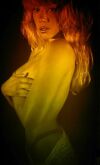
|
Ah well. I forgot to mention that Laser Reflections's big speciality is erotic holography. So I had to buy one too. To be frank, I don't like them as much as their other holograms, although of course the girls are pretty. Probably too contemporary Playboy american style for my taste. The truth is that this particular hologram had two advantages: it's one of my preferred in the playmate serie, and the price was discounted. Check their web site for special offers, it happens from time to time (and I buy most of the holograms when it happens). This hologram is actually so big that I have troubles to light it nicely. [14x24 inches / 35x60 cm] | |
|
|
Still Laser Reflections. After animals, portraits, playmates, here are their plant / flower serie. I'm a plant biologist after all. Once again, very nice. The choice of subject, the composition, the light, the depth, the brightness. The geometrical shape of this Heliconia gives a powerful hologram (and, incidently, reminds me the Brian Aldiss science-fiction book). [12x16 inches / 30x40 cm] | |

|
This hologram was curious because it's reconstructed in blue color, and that's not frequent. It's not evident that it is a plant at first sight. But the "ball" effect is nice, although it's a little bit difficult to light. I don't have it anymore, I offered it to Lolo. I thought her Manhattan appartment was the best place for this blue jewel. [12x12 inches / 30x30 cm] (if I remember correctly) | |

|
A last one. Once again, by Ron and Bernadette Olson, published in the sixth issue of the "Holography MarketPlace", on photopolymer. It was actually an ad for replication facilities on this material made by Dupont. Tough to light correctly because it's still in the book, so it's difficult to have it flat. And my photos suck anyway. But it's a beautiful portrait, that's why I wanted to show it. Quote: "This 3D image is the largest photopolymer hologram ever published in a book". [5x7inches / 12.5x17.5 cm] | |

|
A bit more anecdotic, a photopolymer shot of the "Creature of the Black Lagoon", a very old (1954) excellent fantastic movie, which was one of the first to be projected in stereoscopic 3D. In an interesting "movie inside a movie" scheme, in the 1955 "The Seven Year Itch", Marilyn Monroe and Tom Ewell go out of a theater where they just happened to see The Black Lagoon and talk about the Creature's fate. And then Marilyn, with her white dress, stops on a subway grate and than... You know this ultra-famous scene. Anyway. A funny hologram on photopolymer, with a lot (maybe too much) of depth. Bought on eBay. [I found out later that it comes from a pinball machine. Cool! And I sold it to an enthousiastic pinball machine collector - the first hologram I ever sell in my life] [8x10 inches / 18x24 cm] | |

|
A small and cheap one, very classic use of the "in front of the hologram" technique, but still cool. This is to show you that nice or funny holograms are not necessarily very expensive. [4x5 inches / 10x12.5 cm] | |

|
Last one, just for the fun, because.... I made it. I always wanted to set up a small lab, just to test if I was able to produce some holograms myself. It looks like I can do it. Although it's a bit tricky and complex. I took this photo of my favorite subject, the Cachou Lajaunie licorice box, because it's metallic so I can use magnets to fix it (the biggest ennemy of the holographer is vibration), it fits nicely the size of the smallest 2.5x2.5 emulsion glass plates, and it has sharp patterns on it. This photo is funny, because you can see my holographic clown looking at my hologram. [NEW] I've added a few other pictures too, for fun. [2.5x2.5 inches / 6x6 cm] | |
|
(lots of relatively cheap mass-produced photopolymer holograms, the only thing I could buy when I was young and poor. I'm not showing all of them here. I like them anyway, and they are actually of excellent quality if you think that they can be produced by the thousands. I had no good digital camera when I took these pictures and had to hack a CCD camera which was used for some other purpose) |
||

|

|
A nice little scary demon. [13x9 cm] |
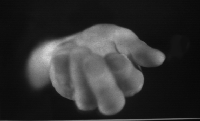
|
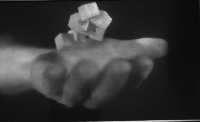
|
Big depth. The hand pops out at least 15 cm in front of the film. Two images. [12x19 cm] |
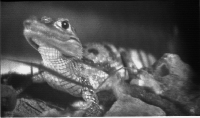
|
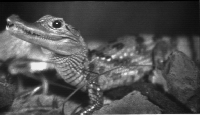
|
Nice baby crocodile. [12x19 cm] |
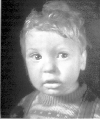
|
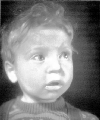
|
Crying baby. [20x24 cm] |
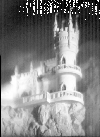
|
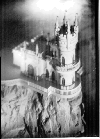
|
On glass, and silver nitrate. Russian quality: brightness and depth are all here. [20x27 cm] |
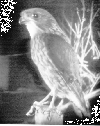
|
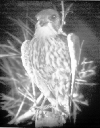
|
Beautiful falcon. [20x24 cm] |

|
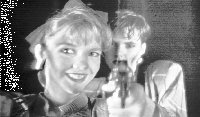
|
I always liked this one, because the girls are pretty and seem dangerous. Holographic femmes fatales. The gun pops out in front of the film. [12x19 cm] |
[guillermito a gmail com] - [Home]